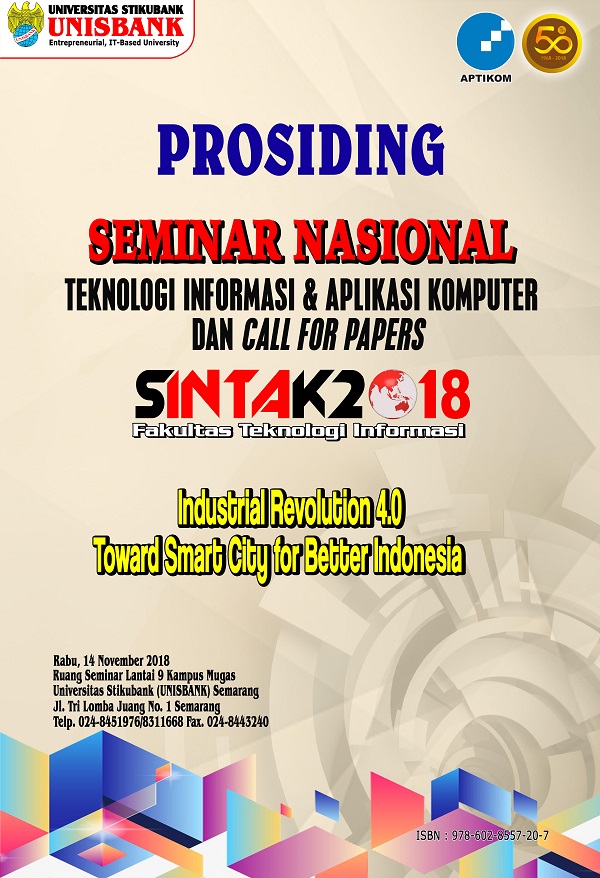MENAKAR KEBERHASILAN E-GOV DALAM PERSPEKTIF E-PARTICIPATION DENGAN INDIKATOR METEP
Abstract
Indonesia merupakan salah satu negara yang menerapkan e-Gov dalam perspektif G2E. Dengan demikian perlu untuk mengetahui sejauh mana keberhasilan penerapan e-parcipation. Melalui indikator METEP yang telah ditetapkan oleh PBB, ukuran keberhasilan e-participation akan dilakukan menggunakan teori pengambilan keputusan yang melibatkan para pemangku kepetingan. Salah satu teori yang saat ini banyak digunakan metode MCDM (Multi Criteria Decision Making) yang didalamnya terdapat teor GDM (Group Decision Making).
Penelitian ini akan menjawab pertanyaan “Bagaimana mengetahui tingkat penerapan e-government dalam perspektif e-participation dengan METEP yang dihitung melalui GDM?”. Dengan melakukan analisis indikator yang sudah dipenuhi oleh pemerintah dalam mengimplementasikan e-participation dan menghitung tingkat keberhasilan e-participation diharapkan dapat menjadi bahan informasi mengenai penerapan dan pengelolaan partisipasi masyarakat. Sehingga dalam keberlanjutan programnya dapat ditentukan strategi yang tepat untuk meningkatkan kepercayaan dan partisipasi masyarakat terhadap pemerintah.
Teknik yang digunakan dalam penelitian ini adalah menggunakan metode METEP. Dari hasil penerapan metode METEP diperoleh informasi terkait dengan e-participation. Hal ini mengindikasikan adanya dorongan percepatan partisipasi elektronik dari para pemangku kepentingan kepada masyarakat maka beberapa indikator alternatif program yang ditetapkan adalah digital inclusive, home page¸dan online services. Adapun kriteria yang harus dipenuhi agar alternatif program tersebut dapat memenuhi harapan para pemangku kepentingan, ditetapkan 3 kriteria dengan bobot presferebsi yang relatif tinggi yaitu: ketersediaan informasi, infrastruktur dan tata kelola.
References
Batson, C. Daniel, Nadia Ahmad, and Jo-Ann Tsang. 2002. “Four Motives for Community Involvement.” Journal of Social Issues 58 (3): 429–45. doi:10.1111/1540-4560.00269.
Bonnemann, Tim. 2008. “What Is Public History.” San Jose, USA: Intellitics.
———. 2010. “Public Participation: Four Common Misconceptions.” San Jose, USA: Intellitics.
Brodie, Ellie, Eddie Cowling, Nina Nissen, Angela Ellis Paine, and Diane Warburton. 2009. “Understanding Participation : A Literature Review.” Pathways through Participation, no. December: 50. http://pathwaysthroughparticipation.org.uk/wp-content/uploads/2009/09/Pathways-literature-review-final-version.pdf.
Cairns, George, George Wright, Ron Bradfield, Kees Van Der Heijden, and George Burt. 2004. “Exploring E-Government Futures through the Application of Scenario Planning $.” North Holland: Technological Forecasting & Social Change 71: 217–38. doi:10.1016/S0040-1625(02)00371-2.
Carpentier, Nico. 2012. “The Concept of Participation. If They Have Access and Interact, Do They Really Participate?” Fronteiras – Estudos Midiáticos 14 (2): 164–77. doi:10.4013/fem.2012.142.10.
Chadwick, Andrew. 2003. “Bringing E-Democracy Back In: Why It Matters for Future Research on E-Governance.” SAGE PublicationsSocial Science Computer Review 21 (4): 443–55. doi:10.1177/0894439303256372.
Clary, E Gil, and Mark Snyder. 1999. “The Motivations to Volunteer: Theoretical and Practical Considerations. Current Directions in Psychological Science.” SAGE Publications 8: 156–59. doi:10.1111/1467-8721.00037.
Clary, E Gil, Mark Snyder, Robert D Ridge, John Copeland, Arthur A Stukas, Julie Haugen, and Peter Miene. 1998. “Understanding and Assessing the Motivations of Volunteers : A Functional Approach.” SAGE Publications 74 (6): 1516–30.
Fuchs, Christian. 2006. “eParticipation Research : A Case Study on Political Online Debate in Austria.” Austria.
Islam, M. Sirajul. 2008. “Towards a Sustainable E-Participation Implementation Model.” European Journal of ePractice 5 (October): 1–12. http://www.epractice.eu/files/5.3.pdf.
Kies, Raphaël. 2012. “Promises and Limits of Web-Deliberation.” New York: RIS ISSN: 0034-9712.
Kim, Soonhee, and Jooho Lee. 2012. “E-Participation, Transparency, and Trust in Local Government” xx: 819–28. doi:10.111/j.1540-6210.2012.02593.x.E-Participation.
Kusumadewi, Sri, Sri Hartati, Agus Harjoko, and Retantyo Wardoyo. 2006. Fuzzy Multi Attribute Decision Making (Fuzzy MADM). 1sted. Yogyakarta: Graha Ilmu.
Lindström, M, M Moghaddassi, and J Merlo. 2003. “Social Capital and Leisure Time Physical Activity: A Population Based Multilevel Analysis in Malmö, Sweden,” 23–28.
Lironi, Elisa. 2016. “Potential and Challenges of E-Participation in the European Union” 1. http://www.europarl.europa.eu/supporting-analyses DISCLAIMER.
Low, N, S Butt, P Ellis, and J Davis Smith. 2007. “Helping Out A National Survey of Volunteering and.” London: Cabinet Office. London. http://openaccess.city.ac.uk/2547/1/Helping Out.pdf.
Macintosh, Ann. 2004. “Characterizing E-Participation in Policy-Making.” Proceedings of the 37th Hawaii International Conference on System Sciences (HICSS-37) 0 (C): 50117a (1-10). doi:10.1109/HICSS.2004.1265300.
“Measuring and Evaluating E-Participation (METEP): Assessment of Readiness at the Country Level.” 2013. United Nation.
OECD. 2003. “The E-Government Imperative.” The OECD Policy Brief, 203 p. http://unpan1.un.org/intradoc/groups/public/documents/APCITY/UNPAN015120.pdf.
Rai, Santosh. 2008. Routes and Barriers to Citizen Governance. York, UK: Joseph Rowntree Foundation.
Roberts, Nancy. 2004. “INVITED ESSAY PUBLIC DELIBERATION IN AN AGE OF DIRECT CITIZEN PARTICIPATION” 34 (4): 315–53. doi:10.1177/0275074004269288.
Rochester, Colin. 2006. Making Sense of Volunteering A Literature Review. The Comission of the Future of Volunteering. http://practicalwisdomr2z.co.uk/consultancy/wp-content/uploads/2011/05/Making-sense-of-volunteering-ROCHESTER-2006.pdf.
Sæbø, Øystein, Jeremy Rose, and Leif Skiftenes Flak. 2008. “The Shape of eParticipation: Characterizing an Emerging Research Area.” Government Information Quarterly 25 (3): 400–428. doi:10.1016/j.giq.2007.04.007.
Slade, Daniel, and Abbi Hobbs. 2015. “Trends in Political Participation.” POST-The Parliamentary Office of Science and Technology-UK. http://researchbriefings.parliament.uk/ResearchBriefing/Summary/POST-PN-0498#fullreport.
Spirakis, Grigorios, Christina Spiraki, and Konstantinos Nikolopoulos. 2010. “The Impact of Electronic Government on Democracy: E-Democracy through E-Participation.” Electronic Government, an International Journal 7 (1): 75–88. doi:10.1504/EG.2010.029892.
Stukas, Arthur A, Mark Snyder, and E Gil Clary. 1999. “The Effects of ‘ Mandatory Volunteerism ’ on Intentions to Volunteer.” American Psichological Society 10 (1): 59–64.
UN DESA. 2003. “E-Participation.” Division for Public Administration and Development Management (DPADM), UNDESA. https://publicadministration.un.org/en/eparticipation.
United Nation. 2010. E-Government Survey 2010.
Warren, M. 1999. “What Is Political.” Journal of Theoretical Politics 11 (April 2017): 207–31. doi:10.1177/0951692899011002004.
West, Darrell M. 2012. “E-Government and the Transformation of Servive Delivery and Citizen Attitudes.” Public Administration 64 (1): 15–27.
Wong, Wilson, and Eric Welch. 2004. “Does E-Government Promote Accountability? A Comparative Analysis of Website Openness and Government Accountability.” Governance 17 (2): 275–97. doi:10.1111/j.1468-0491.2004.00246.x.

